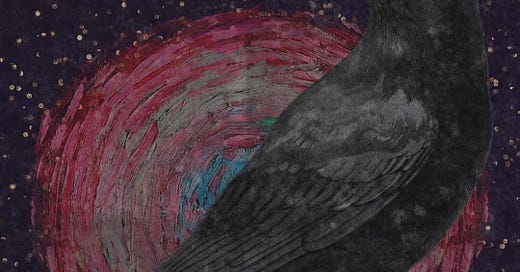In the solstice ritual, in the long darkness, illuminated only by the stars traveling across the sky, the rhythm of three was fulfilled. Three phases, three stages, three bodies. Birth, Life, Death. Three blind women watched over the young woman so that the Great Raven would bless her. This is the cult of beginnings, middles, and ends. Three paths, three possibilities, and three spells. The young woman felt a chill as the Great Raven's feathers brushed her skin, while the Blind Priestesses murmured incantations throughout the long night.
Tum. Tum. Tum.
The Great Raven's deep, starry eyes were fixed on the only one who could look back at him. He blesses her with a shiny black feather, which she delicately burns in the living fire. The feather burns, and the smoke lifts the curtain between worlds. A vast mirrored portal with three doors, reflecting only darkness, rises from the ground. Imposing, massive, and unavoidable.
Tum. Tum. Tum.
The first of the mirrored doors opens, and a thousand white-feathered birds emerge from within. Each one whispers a part of a song, a piece of destiny, a sung map. A melody fills the air with a living, meandering, ever-changing cartography. To follow these fates, to travel these paths, compasses do not work. The last bird to pass through the portal offers her a branch of boxwood, a symbol of eternity.
Tum. Tum. Tum.
With the branch of boxwood in her hand, her body becomes a compass, and the woman opens the second mirrored door.
Inside, she finds a small room with earthen walls, filled with walnuts, chestnuts, and almonds. Possibilities, processes, and eventualities. On the floor are some iron shoes. Trials, challenges, and torments. The three blind women sing for her to put them on, despite the cold, the weight, and the discomfort.
Tum. Tum. Tum.
With heavy feet, she opens the third mirrored door and finds a forest with a mother-of-pearl fountain, glistening in the light of the starry sky, full of caged crows and a washerwoman bent over the water. Under the watchful eye of the Great Raven, the girl crosses the mirrored portal, slowly approaching the washerwoman. The sound of fresh water gushing from the spring becomes increasingly hypnotic. Her feet are heavy, but her iron shoes wear out quickly. On the other side of the mirror, her bare feet touch the damp, cold ground as she asks the washerwoman, “What are you washing?” The washerwoman, silent, merely lifts the feather cloak soaked with her dripping, calloused, strong hands. Under the gaze of the Great Raven and the lamentations of the three Blind Women, the girl advances to the mother-of-pearl fountain and, with the washerwoman, washes the cloak, delicately rubbing and brushing the feathers.
Tum. Tum. Tum.
The washerwoman, who has always washed and carried the souls of the dead through the waters, tenderly dresses her in the feather cloak, pushing her back through the doorway. The chains fall and the cages open. The birds fly away, and the fruits ripen. The walnuts, chestnuts, and almonds take root. The waters flow, and the fire dies down. The smoke dissipates. Here, on the longest night, the rhythm of three has been restored and blessed by the Great Raven, the wise one of the fertile night. The young woman, covered in feathers, now knows how to fly between worlds, guided by the voices of the three Blind Women and the boxwood branch.
Cycle of tales of Eco-Mythical Activism
A short story, written by me, with an eco-mythological, totemic and animistic plot, inspired by the traditional tale “The Crow's Bride.”
As I wrote in elsewhere: For example, the tale “The Crow's Bride” tells the story of a woman with a crow in her company. The raven wanted to marry her, so she sent for the eldest of three beautiful sisters who lived nearby; the girl replied that she would not marry the raven, and he angrily plucked out her eyes. Eventually, the third sister agreed to marry the raven, and after many adventures—burning feathers, walking across the land in iron shoes, a mother-of-pearl fountain with a washerwoman dressed in feathers, and the disenchantment of birds that were princes, all the symbolic elements of primordial ceremonies, now completely lost—the girl managed to marry the raven, who was, in fact, an enchanted king.
I’m working to make all posts open to everyone. Paid subscriptions help support the depth of this research, allowing these narratives to continue gestating outside institutional and market demands. You’re invited to support if you feel called, but your presence here, as a living witness, is already part of the story. You can also check out my online bookstore.
Honor hystera. Re-member. Response-ability. (Un)learn together.




